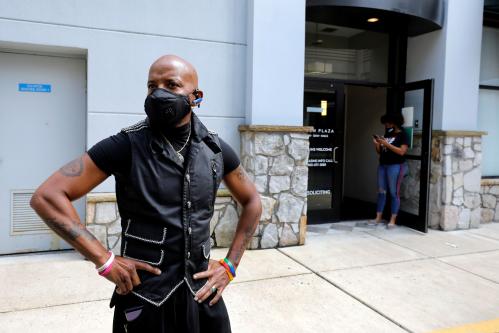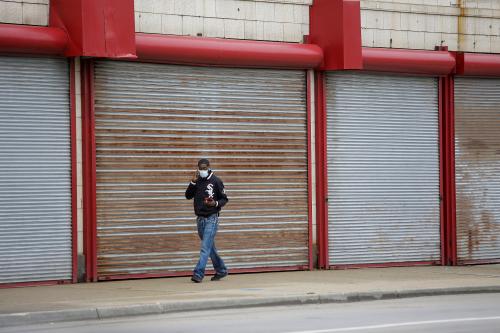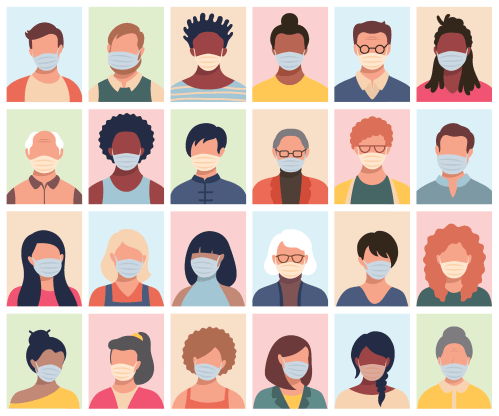We explore these issues in greater detail in a longer paper here.
The COVID-19 pandemic was an exponential shock to much of the U.S., and exposed deep vulnerabilities across our fragmented health care system and levels of income. We know that African Americans who suffer from racial and income inequalities, also suffered disproportionately from COVID-19 incidences and mortality. Predominantly Black counties have COVID-19 infection rates that are nearly three times higher than that of predominantly white counties. According to the CDC, while they make up just 12.5% of the U.S. population, they account for 23% of COVID-19 deaths and are 3.5 times more likely to die from the disease compared to white populations.
This occurred for many reasons. African Americans are over-represented in “essential” jobs in the health and transportation sectors where social distancing is impossible, from an early age through death often lack access to good health care and are more likely to be poor. Longer term systemic barriers linked to racism in housing, opportunity, and other realms have exacerbated these problems. Due to these barriers, African Americans are also more likely to have pre-existing health conditions such as asthma, diabetes, and cardiovascular diseases, which are all risk factors for COVID-19.
With the support of the Social Policy Institute at Washington University in St. Louis, we conducted a nationally representative survey with approximately 5,500 respondents in all 50 states from April 27 to May 12, 2020 to explore Americans’ sense of well-being. Given the disproportionate impact of COVID-19 on African Americans, it would be logical to expect African Americans to demonstrate the highest losses in mental health and other dimensions of well-being. Yet, that is not what we found.
When we asked respondents where they think they will be in three months and in five years, respectively, we found large differences in well-being across races. Reported life satisfaction – and particularly optimism for the future – between African Americans and whites are almost as large as those across income groups. African Americans also report better mental health than whites, with the most significant disparities occurring between low-income blacks and low-income whites. Hispanics also score higher on life satisfaction and optimism and have slightly better mental health than whites, but the gaps are not as large as those between African Americans and whites.[1]
A key feature of COVID-19 is the uncertainty and deprivation it has brought to the lives of millions through unemployment. When we look at employment status during COVID-19, we find that virtually all changes in status are worse for well-being and mental health than they are for keeping one’s employment. However, we also found surprising racial differences across those changes.
Although African Americans, who are over-represented in essential jobs, were less likely to become unemployed, those who did lose their jobs stand out for their resilience to such shocks. We found that African Americans (across all incomes) who lost their jobs are both more optimistic and report better mental health than whites who have lost their jobs. This may be due to more experience with and adaptation to job insecurity among African Americans, or it may simply reflect general levels of higher resilience. Both traits are likely at play and seem to be protective of mental health and other similar challenges.
These findings seem puzzling in the face of the objective disparities between low-income African Americans and other groups, as well as the disproportionate burden they have suffered from COVID-19. Nonetheless, they are remarkably consistent with patterns that we have previously found in the well-being of different race and income cohorts amidst opioid-related deaths of despair. Using over one million responses over five years from Gallup data for the U.S., we find large gaps in optimism and reported stress across poor African Americans and whites, with the former almost three times as likely to be a point higher on the 11 point optimism scale and 50% less likely to report experiencing stress the previous day than poor whites (poor Hispanics again fall in between the two groups on the same markers).
The reasons for this resilience among African Americans are complex. They include a historical trajectory of overcoming adversity, strong community ties, and continued belief in the promise of education at a time that it has faded among low-income whites. As a result, African Americans and Hispanics are gradually narrowing gaps in education and life expectancy with whites. Poor whites, meanwhile, have fallen behind in absolute terms compared to wealthy whites and in relative terms compared to minorities, losses which are reflected in their high levels of despair.
Contrary to what we would have expected given the demography of disease incidence and other costs brought on by COVID-19, African Americans retain higher levels of resilience – more optimism and better mental health – than whites. While this is not a well-known story, it is one with potential lessons for those coping with COVID-19-related uncertainty and other challenges.
The direct policy implications of these results are not immediately obvious, as these differences stem from deep and complex long-term trends. Yet the new “science” of well-being is increasingly yielding lessons on how simple interventions can enhance well-being in deprived and isolated communities, and on how and when resilience can be learned. As the U.S. is facing unprecedented challenges due to the dual “pandemics” of COVID-19 and racial injustice – with implications for the physical and mental health of our society, it is time to better understand the roots of African American resilience, as those, in turn, will play a vital role in healing our deeply divided society going forward.
[1] The CDC’s “pulse’ survey, conducted from late April to early June, found that Blacks reported increased anxiety during this period (https://www.cdc.gov/nchs/covid19/health-care-access-and-mental-health.htm). While they reported less anxiety than Hispanics and “other” racial groups, they reported more anxiety than whites. The question in the CDC is quite different from either the optimism or mental health in general ones that we use. It is: “Over the last 7 days, how often have you been bothered by the following problems … Feeling nervous, anxious, or on edge?” Clearly it is plausible that anxiety might increase at the intersect of COVID and widespread protests against racial discrimination, but that optimism could remain high at the same time. In addition, the pulse data combines all income groups, which the differences that we find, as is clear from the figures below are greatest between low income Blacks and whites.











Commentary
Resilience in the face of a pandemic: COVID weighs unevenly across racial lines
June 24, 2020